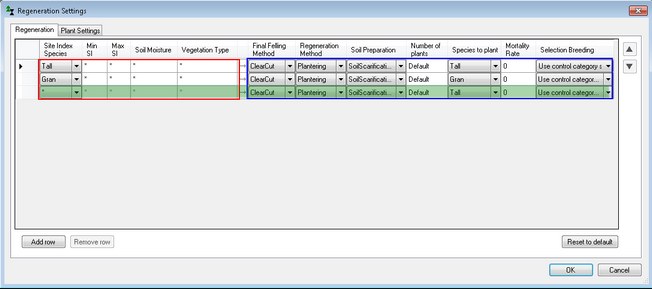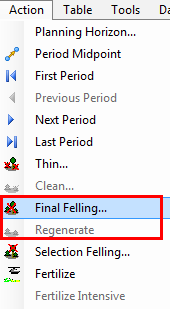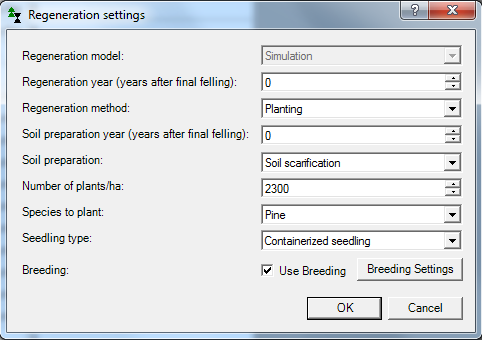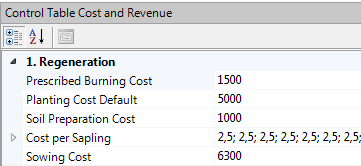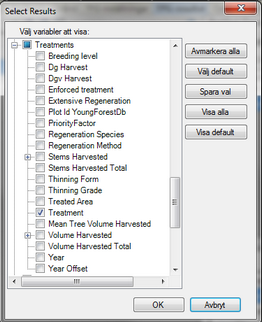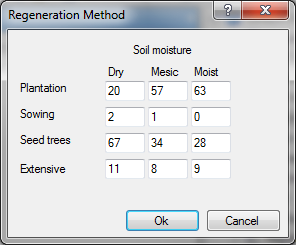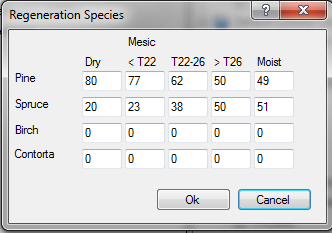Regeneration
In Heureka you can simulate regeneration as planting, sowing or natural regeneration. In this chapter you will learn about how to control how regeneration is simulated and how costs are calculated.

Figure 1.
Heureka simulates young stand "completion" at a mean height of about 2 meters. The time when this occurs is called the activation time. The state of the trees between the regeneration treatment and the activation time is obtained by interpolation.
When a regeneration is applied, a tree height distribution is calculated, from which tree objects are created. Separate distributions are created for a number of the species. The main crop species is the species you select as Regeneration Species. In addition, a number of "secondary species" are created. In a conifer stand, the secondary species are birch, and spruce or pine, depending on the crop species. So, for simulated spruce plantations there will also be a lot of naturally occurring birch trees.
You can also regenerate with Lodgepole pine (Pinus contorta), aspen, beech, oak and larch (Larix sibirica). For beech and oak, no secondary species will be generated, there are no models available for this. |
Regeneration settings can be found in the Treatment Model control table, under Regeneration Settings. Please note the following:
Figure 2.
You can enter different regeneration methods for different site data conditions. In the area marked in red in Figure 2, under the Regeneration tab, you can enter site restrictions based on site index, site index species, soil moisture, and vegetation type. Min SI and Max SI can be entered to define a site index interval. An asterisk (*) means that all values are accepted, for example "Max SI = *" means that there is no upper limit for site index. You can add more rows on top of the default row. The default row includes all sites that do meet the criteria of another row, and therefore you cannot change the site criteria for the default row. In version 2.5 and later you can select "Auto" as Species to plant. This choice means that the main species is used as regeneration species.
For each row, even the default row, you can specify how final felling should be performed (since it affects the regeneration, for example if you leave seed trees), regeneration method (the available options depend on the Final felling method selected), soil preparation method, number of plants, tree species, and whether bred material should be used. The number of plants should normally be set to Default, and then entered in more detail in Plant Settings.
Regeneration method and final felling methodAs the regeneration method you can choose planting, sowing or natural regeneration with seed trees. Natural regeneration is only available for pine. The selection of regeneration method is linked to the choice of final felling method. Natural regeneration requires retention of seed trees when final felling occurs, and you must set the final felling method to "Seed Trees" to be able to select "Natural Regeneration" as the regeneration method.
Shelterwood is used in combination with planting, and does not result in a natural regeneration (unlike with seed trees).
The choice of trees retained as seed trees or in shelterwoods is set in the Treatment Model control table, under Final Felling.
Tree species and number of plantsYou can choose to regenerate with one of the following species: Pine (Pinus sylvestris), Spruce (Picea abies), Birch (Betula sp.), Aspen (Populus termula), Contorta (Pinus contorta, Lodgepole pine), Oak (Quercus robur), Beech (Fagus sylvatica) or Larch (Larix sibirica). In the tab "Plant Settings", you can enter default values for the number of trees to plant for different species and site indexes.
Soil preparation methodYou can choose between Soil scarification, Control burning (hyggesbränning) and None. Currently, the regeneration model used in Heureka gives almost the same regeneration result with and without soil preparation and thus mainly affects the cost. However, there are plans to implement the possibility to add different plant survival rates for different methods. |
In StandWise you choose the regeneration method when you simulate a final felling, or a stand that has no trees in year 0, when you select the action Regenerate. To see the regeneration results, step forward one period.
|
Regeneration cost settings are found in the Regeneration section of the Cost and Revenues control table:
|
Information on regeneration treatments are saved in some of the result variables of the Treatment results category. These variables can be used to create restrictions in an optimization model, for example to limit the area of Lodgepole pine that can be planted in a period (see the optimization chapter).
Figure 4. |
The Treatment Model control table looks a bit different in RegWise than in PlanWise and StandWise. The choice of regeneration method and regeneration species have separate settings:
Figure 5.
Regeneration MethodIn RegWise, the desired area distribution of regeneration methods is set for each of three soil moisture classes. The example below (Figure 6) means that 20 % of the regeneration area on dry soils should be planted, 2 % sown, 67 % naturally regenerated, and 11 % should be extensively regenerated ("extensively" is a special option available only in RegWise).
Figure 6.
Note! "Extensive" is used for a regeneration area that has not or will not be actively regenerated. This refers to small objects, where for example sufficient seed trees have not been retained. However, the assumption is that the area has a sufficient density of plants to form a future stand.
Regeneration SpeciesIn RegWise, the desired area distribution of regeneration species is set in the Regeneration Species dialog. The table is similar to that for Regeneration Method above, but the Mesic soil moisture class is subdivided into three site index classes. The example below (figure 7) means that 80 % of the regeneration area on dry soils should be regenerated with pine and 20 % with spruce.
Figure 7. |


